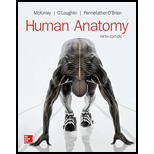
LooseLeaf for Human Anatomy
5th Edition
ISBN: 9781259285271
Author: Michael McKinley Dr., Valerie O'Loughlin, Elizabeth Pennefather-O'Brien
Publisher: McGraw-Hill Education
expand_more
expand_more
format_list_bulleted
Question
Chapter 27, Problem 3WYL
Summary Introduction
To determine:
The location of renal medulla and renal cortex.
Introduction:
Kidneys are present on the posterior abdominal wall. They regulate the volume of blood and interstitial fluid under the influence of hormones like rennin and aldosterone. The kidney can also measure the oxygen level of the body as it filters the blood.
Expert Solution & Answer
Want to see the full answer?
Check out a sample textbook solution
Students have asked these similar questions
Hair follicle formation is thought to result from a reaction-diffusion mechanism with Wnt and its antagonist Dkk1. How is Dkk1 regulated by Wnt? Describe specific cis-regulatory elements and the net effect on Dkk1 expression.
Limetown S1E4 Transcript: E
n 2025SP-BIO-111-PSNT1: Natu
X
Natural Selection in insects
X
+
newconnect.mheducation.com/student/todo
CA
NATURAL SELECTION NATURAL SELECTION IN INSECTS (HARDY-WEINBERG LAW)
INTRODUCTION
LABORATORY SIMULATION
A Lab Data
Is this the correct allele frequency?
Is this the correct genotype frequency?
Is this the correct phenotype frequency?
Total
1000
Phenotype Frequency
Typica
Carbonaria
Allele Frequency
9
P
635
823
968
1118
1435
Color
Initial Frequency
Light
0.25
Dark
0.75
Frequency Gs
0.02
Allele
Initial Allele Frequency
Gs Allele Frequency
d
0.50
0
D
0.50
0
Genotype Frequency
Moths
Genotype
Color
Moths
Released
Initial
Frequency
Frequency G5
Number of
Moths Gs
NC
- X
Which of the following is not a sequence-specific DNA binding protein?
1. the catabolite-activated protein
2. the trp repressor protein
3. the flowering locus C protein
4. the flowering locus D protein
5. GAL4
6. all of the above are sequence-specific DNA binding proteins
Chapter 27 Solutions
LooseLeaf for Human Anatomy
Ch. 27 - What organs make up the urinary tract, and what is...Ch. 27 - Describe the mechanisms by which the kidneys...Ch. 27 - Prob. 3WYLCh. 27 - Prob. 4WYLCh. 27 - Prob. 5WYLCh. 27 - Prob. 6WYLCh. 27 - Prob. 7WYLCh. 27 - Prob. 8WYLCh. 27 - Prob. 9WYLCh. 27 - Prob. 10WYL
Ch. 27 - Prob. 11WYLCh. 27 - Prob. 12WYLCh. 27 - Prob. 13WYLCh. 27 - Prob. 14WYLCh. 27 - Prob. 15WYLCh. 27 - Prob. 16WYLCh. 27 - Prob. 17WYLCh. 27 - Match each numbered item with the most closely...Ch. 27 - Prob. 1MCCh. 27 - Prob. 2MCCh. 27 - Prob. 3MCCh. 27 - Prob. 4MCCh. 27 - The arteries located at the corticomedullary...Ch. 27 - Prob. 6MCCh. 27 - Prob. 7MCCh. 27 - Prob. 8MCCh. 27 - Reabsorption is the movement of fluid and solutes...Ch. 27 - The micturition reflex controls a. urine...Ch. 27 - Prob. 1CRCh. 27 - Describe the connective tissue coverings that...Ch. 27 - Prob. 3CRCh. 27 - Prob. 4CRCh. 27 - Prob. 5CRCh. 27 - Prob. 6CRCh. 27 - What prevents urine stored in the urinary bladder...Ch. 27 - Prob. 8CRCh. 27 - Trace the course of fluid movement, beginning with...Ch. 27 - What is the cause of a urinary tract infection?...Ch. 27 - Prob. 1DCRCh. 27 - Males who suffer from either benign prostatic...
Knowledge Booster
Learn more about
Need a deep-dive on the concept behind this application? Look no further. Learn more about this topic, biology and related others by exploring similar questions and additional content below.Similar questions
- Which of the following is not a DNA binding protein? 1. the lac repressor protein 2. the catabolite activated protein 3. the trp repressor protein 4. the flowering locus C protein 5. the flowering locus D protein 6. GAL4 7. all of the above are DNA binding proteinsarrow_forwardWhat symbolic and cultural behaviors are evident in the archaeological record and associated with Neandertals and anatomically modern humans in Europe beginning around 35,000 yBP (during the Upper Paleolithic)?arrow_forwardDescribe three cranial and postcranial features of Neanderthals skeletons that are likely adaptation to the cold climates of Upper Pleistocene Europe and explain how they are adaptations to a cold climate.arrow_forward
- Biology Questionarrow_forward✓ Details Draw a protein that is embedded in a membrane (a transmembrane protein), label the lipid bilayer and the protein. Identify the areas of the lipid bilayer that are hydrophobic and hydrophilic. Draw a membrane with two transporters: a proton pump transporter that uses ATP to generate a proton gradient, and a second transporter that moves glucose by secondary active transport (cartoon-like is ok). It will be important to show protons moving in the correct direction, and that the transporter that is powered by secondary active transport is logically related to the proton pump.arrow_forwarddrawing chemical structure of ATP. please draw in and label whats asked. Thank you.arrow_forward
- Outline the negative feedback loop that allows us to maintain a healthy water concentration in our blood. You may use diagram if you wisharrow_forwardGive examples of fat soluble and non-fat soluble hormonesarrow_forwardJust click view full document and register so you can see the whole document. how do i access this. following from the previous question; https://www.bartleby.com/questions-and-answers/hi-hi-with-this-unit-assessment-psy4406-tp4-report-assessment-material-case-stydu-ms-alecia-moore.-o/5e09906a-5101-4297-a8f7-49449b0bb5a7. on Google this image comes up and i have signed/ payed for the service and unable to access the full document. are you able to copy and past to this response. please see the screenshot from google page. unfortunality its not allowing me attch the image can you please show me the mathmetic calculation/ workout for the reult sectionarrow_forward
arrow_back_ios
SEE MORE QUESTIONS
arrow_forward_ios
Recommended textbooks for you
 Human Biology (MindTap Course List)BiologyISBN:9781305112100Author:Cecie Starr, Beverly McMillanPublisher:Cengage Learning
Human Biology (MindTap Course List)BiologyISBN:9781305112100Author:Cecie Starr, Beverly McMillanPublisher:Cengage Learning Concepts of BiologyBiologyISBN:9781938168116Author:Samantha Fowler, Rebecca Roush, James WisePublisher:OpenStax College
Concepts of BiologyBiologyISBN:9781938168116Author:Samantha Fowler, Rebecca Roush, James WisePublisher:OpenStax College Human Physiology: From Cells to Systems (MindTap ...BiologyISBN:9781285866932Author:Lauralee SherwoodPublisher:Cengage Learning
Human Physiology: From Cells to Systems (MindTap ...BiologyISBN:9781285866932Author:Lauralee SherwoodPublisher:Cengage Learning


Human Biology (MindTap Course List)
Biology
ISBN:9781305112100
Author:Cecie Starr, Beverly McMillan
Publisher:Cengage Learning

Concepts of Biology
Biology
ISBN:9781938168116
Author:Samantha Fowler, Rebecca Roush, James Wise
Publisher:OpenStax College



Human Physiology: From Cells to Systems (MindTap ...
Biology
ISBN:9781285866932
Author:Lauralee Sherwood
Publisher:Cengage Learning
Excretory System; Author: Amoeba Sisters;https://www.youtube.com/watch?v=q5qaGHfdmYM;License: Standard youtube license